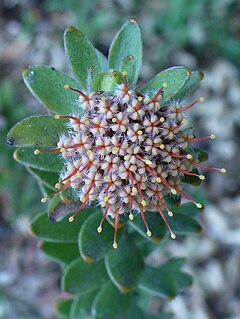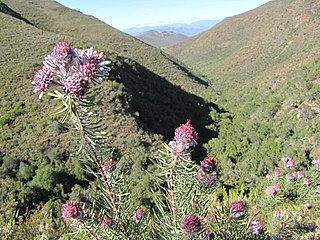
Quercus montana, the chestnut oak, is a species of oak in the white oak group, Quercus sect. Quercus. It is native to the eastern United States, where it is one of the most important ridgetop trees from southern Maine southwest to central Mississippi, with an outlying northwestern population in southern Michigan. It is also sometimes called rock oak because of its presence in montane and other rocky habitats. As a consequence of its dry habitat and ridgetop exposure, it is not usually a large tree, typically 18–22 m (59–72 ft) tall; occasional specimens growing in better conditions can however become large, with trees up to 40–43 m (131–141 ft) tall known. They tend to have a similar spread of 18–22 m (59–72 ft). A 10-year-old sapling grown in full sun will stand about 5 m (16 ft) tall. This species is often an important canopy species in an oak-heath forest.

Hoya is a genus of 200–300 species of tropical plants in the family Apocynaceae (Dogbane). Most are native to several countries of Asia such as China, India, Thailand, Malaysia, Vietnam, Bangladesh, and Indonesia, There is a great diversity of species in the Philippines, and species in Polynesia, New Guinea, and Australia.

Saxegothaea is a genus comprising a single species, Saxegothaea conspicua. It is a conifer in the podocarp family Podocarpaceae, native to southern South America. It grows in Chile and Argentina from 35° to 46° South latitude; in its northernmost natural distribution it grows between 800 and 1000 (2600–3300 ft) m above sea level and in the south it lives at sea level. The species is most often known by its genus name, or sometimes as female maniu and Prince Albert's yew; in South America it is known as mañío hembra or maniú hembra.

Aralia spinosa, commonly known as devil's walking stick, is a woody species of plant in the genus Aralia, family Araliaceae, native to eastern North America. The various names refer to the viciously sharp, spiny stems, petioles, and even leaf midribs. It has also been known as Angelica-tree.

Zanthoxylum clava-herculis is a spiny tree or shrub native to the southeastern United States. It grows to 10–17 m tall and has distinctive spined thick, corky lumps 2–3 cm long on the bark. The leaves are glabrous and leathery, pinnately compound, 20–30 cm long with 7-19 leaflets, each leaflet 4–5 cm long. The flowers are dioecious, in panicles up to 20 cm long, each flower small, 6–8 mm diameter, with 3-5 white petals. The fruit is a two-valved capsule 6 mm diameter with a rough surface, and containing several small black seeds. The tree has also been called Z. macrophyllum. The genus name is sometimes spelled Xanthoxylum.

Prosopis alba is a South American tree species that grows in central Argentina, the Gran Chaco ecoregion, and part of the Argentine Mesopotamia, as well as Bolivia, Paraguay, and Peru. It is known as algarrobo blanco in Spanish, which means "white carob tree". Spanish settlers gave it that name because of its similarity to the European carob tree. Other common names come from Guaraní, including ibopé and igopé.

Hylocereus undatus, the white-fleshed pitahaya, is a species of Cactaceae and is the most cultivated species in the genus. It is used both as an ornamental vine and as a fruit crop - the pitahaya or dragon fruit. The native origin of the species has never been resolved.

Castanea pumila, commonly known as the Allegheny chinquapin, American chinquapin or dwarf chestnut, is a species of chestnut native to the southeastern United States. The native range is from Maryland and extreme southern New Jersey and southeast Pennsylvania south to central Florida, west to eastern Texas, and north to southern Missouri and Kentucky. The plant's habitat is dry sandy and rocky uplands and ridges mixed with oak and hickory to 1000 m elevation. It grows best on well-drained soils in full sun or partial shade.

Banksia violacea, commonly known as violet banksia, is a species of shrub or tree in the plant genus Banksia. It generally grows as a small shrub to 1.5 m (5 ft) high with fine narrow leaves, and is best known for its unusually coloured dark purple-violet inflorescences. The colour of the inflorescences, short leaves, and flattened follicles which are sticky when young, help identify this species from others in the field. It is found in low shrubland in southern regions of Western Australia from Esperance in the east to Narrogin in the west, growing exclusively in sandy soils.

Cephalotaxus fortunei, commonly called the Chinese plum-yew, Fortune's yew plum, simply plum yew, Chinese cowtail pine or in Chinese as san jian shan, is a coniferous shrub or small tree in the family Taxaceae. It is native to northern Burma and China, but is sometimes grown in western gardens where it has been in cultivation since 1848.

Mimetes arboreus, or Kogelberg pagoda, is an evergreen, upright large shrub or small tree of 2–6 m (6½–20 ft) high in the family Proteaceae. It grows from a thick trunk with a smooth grey bark that branches at ½–1 m (1½–3 ft) above the ground. It has silvery, lance-shaped, pointy leaves of 5–8¼ cm (2.0–3.3 in) long and ¾–3¼ cm (0.3–1.3 in) wide, at an upward angle and overlapping each other. The inflorescences are set just below the top of the branches, are cylinder-shaped, 8–10 cm in diameter, topped by a crest of more or less horizontal pinkish or reddish tinged leaves. It consists of several flower heads in the axils of pinkish orange leaves that form a hood shielding the underlying flower head. Each flower head contains eight to thirteen individual flowers, with bright red styles and grey silky perianth lobes. It is endemic to the Fynbos ecoregion of South Africa, being confined to the Kogelberg mountain range.

Mimetes chrysanthus is an evergreen, upright shrub of 1½–2 m high that has been assigned to the family Proteaceae. It has green, slightly stalked oval leaves of 3–4½ cm (1.2–1.8 in) long and 1–1¾ cm (0.4–0.7 in) wide. The inflorescences are near the tip of the branches, cylinder-shaped and consist of 50–70 densely cropped flower heads, each in the axil of a green leaf, consisting of 25–35 golden yellow, faintly sweet scented flowers. It is endemic to the Fynbos ecoregion of South Africa and is found in two locations, in the Western Cape province. The flowering season is from March to May or June, but flower heads sometimes occur in any other part of the year.
Pitavia punctata is a species of tree endemic to Chile in the family Rutaceae. It is endemic to Chile; an example habitat being the Chilean matorral. It is threatened by habitat loss. Distinctive common names: Pitao, Pitran. It is found from Maule to Malleco.

Echinopsis chiloensis is a species of cacti native to South America; genus members are known as hedgehog cacti, sea-urchin cactus or Easter lily cactus.
The Yantai stingray, Hemitrygon laevigata, is a little-known species of stingray in the family Dasyatidae, inhabiting shallow waters in the northwestern Pacific Ocean off the coasts of China and Japan. Measuring no more than 20–30 cm (7.9–11.8 in) across, this species is characterized by its diamond-shaped pectoral fin disc wider than long, completely smooth skin, dorsal coloration of dark irregular spots on a yellowish gray-brown background, and ventral coloration of more spots on a white background with yellowish margins. One of the three most common stingrays sold for food in China, the slow-reproducing Yantai stingray faces possible overfishing and habitat degradation, and its numbers appear to be declining. The International Union for Conservation of Nature (IUCN) has assessed it as Near Threatened.

Thelocactus setispinus, known commonly as miniature barrel cactus or hedgehog cactus, is a cactus in the genus Thelocactus of the family Cactaceae.

Berberis ilicifolia, sometimes called holly barberry or holly-leaved barberry is a medium to high, spiny shrub belonging to the barberries in the family Berberidaceae. The local name in Chile is Chelia. It has ovate leaves with a few teeth that end in spines, reminiscent of holly leaves. Its orange flowers grow with three to seven together, which later produce globose blue-black berries. The species originates south of 40ºS in Argentina and Chile, where it grows in Nothofagus woods. Flowers are present from August to December, while ripe berries are available between November and March.

Leucospermum truncatulum is a slender, upright, evergreen, hardly branching shrub of up to 2 m (6 ft) high, with felty inverted egg-shaped to oval, leaves with entire margins of 1–2½ cm (0.4–1.0 in) long and ½–1 cm (0.2–0.4 in) wide. It has small globe-shaped, at first yellow, later pinkish flower heads of 1½–2 cm (0.6-0.8 in) in diameter, without a stalk, usually crowded with two to eight together near the end of the stems. It is known as oval-leaf pincushion in English, and patrysbos or kleinkopspeldekussing in Afrikaans. It is an endemic species of the south of the Western Cape province of South Africa, and flowers between August and December.

Leucospermum heterophyllum is a low, trailing evergreen shrublet of up to 15 cm (6 in) high, and up to several m in diameter, which is assigned to the family Proteaceae. It has narrow leaves of about 2½ cm (1 in) long and ½ cm (0.2 in) wide, mostly with three teeth near its tip. It has small, globe-shaped, whitish flower heads. It is called trident pincushion in English and rankluisie in Afrikaans. It naturally occurs in the Western Cape province of South Africa. The plant flowers between August and January.

Vexatorella latebrosa, also known as the Robertson vexator, is an evergreen, upright shrub of up to about 1½ m high, from the family Proteaceae. It has entire, long inverted egg-shaped, bluish grey, leathery leaves that are line-shaped to very narrowly spade-shaped in outline, 5–6½ cm (2.0–2.6 in) long and 2–3 mm (0.08–0.12 in), and mostly solitary globular flower heads at the end of the branches of 2½–3 cm (0.8 in) across with scented, pink to carmine flowers with extended, styles with a thickened tip. The plants are flowering from August to September. It is an endemic species that is restricted to the Western Cape province of South Africa.



















